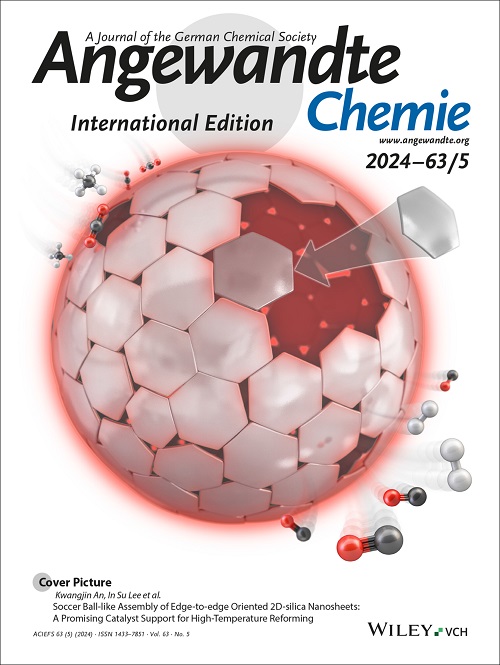Amorphous Nitride‐chloride Solid‐State Electrolytes for High Performance All‐solid‐state Lithium Batteries
IF 16.9
1区 化学
Q1 CHEMISTRY, MULTIDISCIPLINARY
引用次数: 0
Abstract
High‐performance solid‐state electrolytes (SSEs) are crucial for advancing all‐solid‐state batteries (ASSBs). Amorphous SSEs, in particular, offer promising advantages due to their grain‐boundary‐free nature, which facilitates intimate solid‐to‐solid contact and uniform lithium‐ion flux, thereby improving composite electrode performance. Here, we report a class of SSEs based on a nitrogen‐chlorine dual‐anion framework, formulated as Li3x+0.1ZrNxCl4.1, for high‐voltage ASSBs. Unlike widely studied crystalline Li2ZrCl6 with a triclinic structure, increased N3− substitution drives a structural transition to an amorphous phase (Li1.3ZrN0.4Cl4.1), which achieves a significant enhancement in Li+ conductivity from 0.46 mS cm−1 to 3.01 mS cm−1, alongside improved oxidative stability up to 4.8 V. This dual‐anion SSEs exhibits excellent compatibility with high‐energy LiNi0.83Co0.06Mn0.11O2 (NCM83) cathodes. The corresponding full cells deliver a high reversible capacity of 200.1 mAh g−1 at 4.5 V with outstanding capacity retention of 95.1% after 150 cycles at 0.2 C, along with remarkable long‐term cycling stability exceeding 3,000 cycles at 3 C. Furthermore, the electrochemical stability of Li1.3ZrN0.4Cl4.1 in conjunction with NCM83 is still preserved under elevated temperatures (50 °C) and higher cut‐off voltages (up to 4.8 V). These results highlight the promise of dual‐anion amorphous electrolytes, paving the way for the design of next‐generation SSEs beyond traditional single‐anion systems.用于高性能全固态锂电池的非晶态氮氯化物固态电解质
高性能固态电解质(ses)是推进全固态电池(assb)的关键。特别是非晶态ssi,由于其无晶界的性质,促进了密切的固对固接触和均匀的锂离子通量,从而提高了复合电极的性能,提供了有前途的优势。在这里,我们报道了一类基于氮氯双阴离子框架的高压assb,分子式为Li3x+0.1ZrNxCl4.1。与广泛研究的具有三斜结构的Li2ZrCl6晶体不同,N3 -取代的增加驱动结构转变为非晶相(Li1.3ZrN0.4Cl4.1),这使得Li+电导率从0.46 mS cm - 1显著提高到3.01 mS cm - 1,同时氧化稳定性提高到4.8 V。该双阴离子sss与高能LiNi0.83Co0.06Mn0.11O2 (NCM83)阴极具有良好的相容性。相应的完整电池在4.5 V下提供200.1 mAh g - 1的高可逆容量,在0.2 C下循环150次后的容量保持率为95.1%,以及在3 C下超过3000次的长期循环稳定性。此外,Li1.3ZrN0.4Cl4.1与NCM83结合在一起,在高温(50°C)和更高的截止电压(高达4.8 V)下仍然保持电化学稳定性。这些结果突出了双阴离子非晶电解质的前景,为设计超越传统单阴离子体系的下一代ssi铺平了道路。
本文章由计算机程序翻译,如有差异,请以英文原文为准。
求助全文
约1分钟内获得全文
求助全文
来源期刊
CiteScore
26.60
自引率
6.60%
发文量
3549
审稿时长
1.5 months
期刊介绍:
Angewandte Chemie, a journal of the German Chemical Society (GDCh), maintains a leading position among scholarly journals in general chemistry with an impressive Impact Factor of 16.6 (2022 Journal Citation Reports, Clarivate, 2023). Published weekly in a reader-friendly format, it features new articles almost every day. Established in 1887, Angewandte Chemie is a prominent chemistry journal, offering a dynamic blend of Review-type articles, Highlights, Communications, and Research Articles on a weekly basis, making it unique in the field.

 求助内容:
求助内容: 应助结果提醒方式:
应助结果提醒方式:


